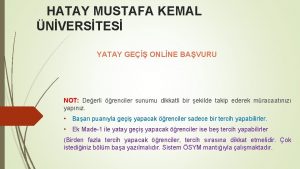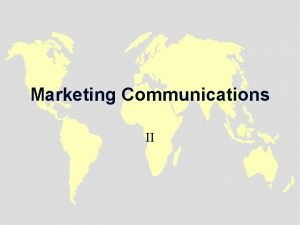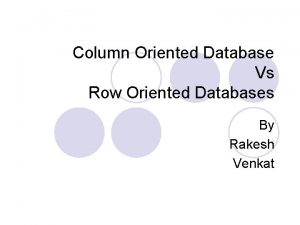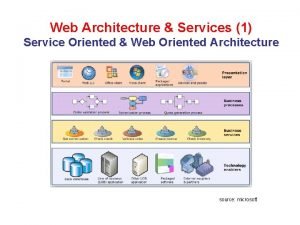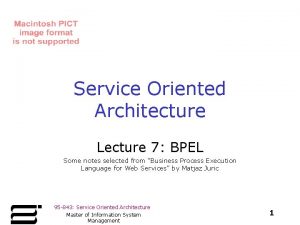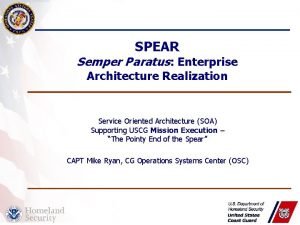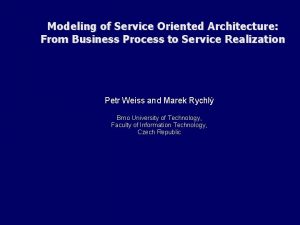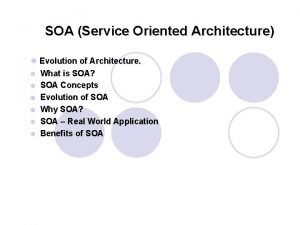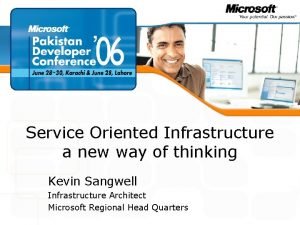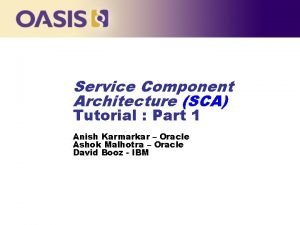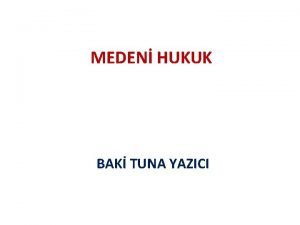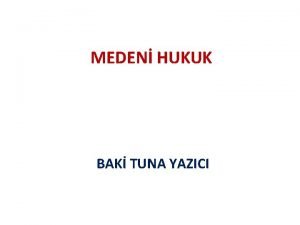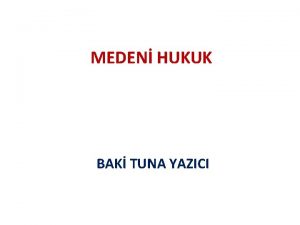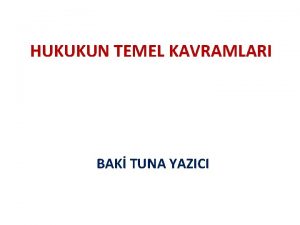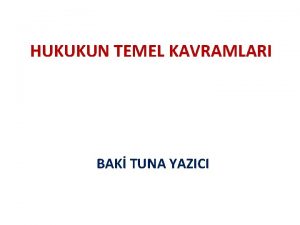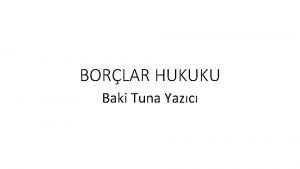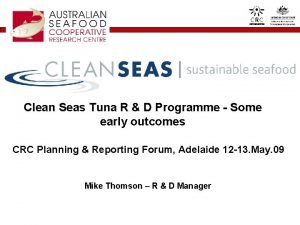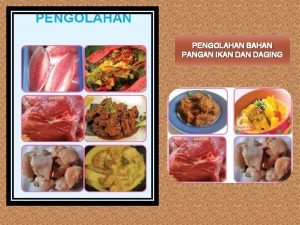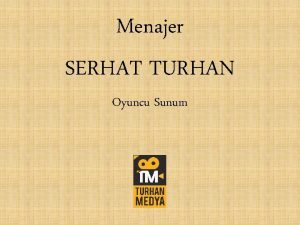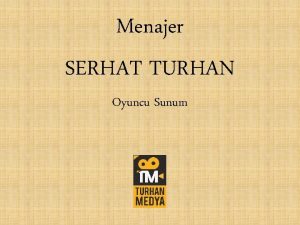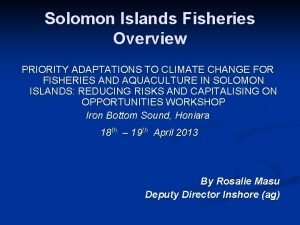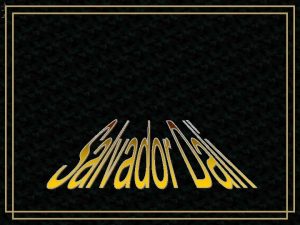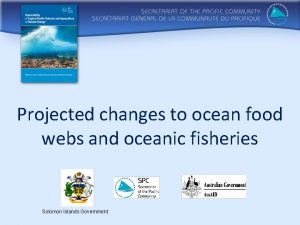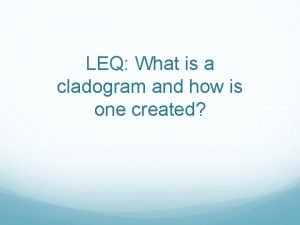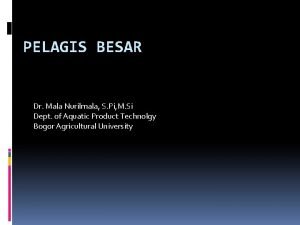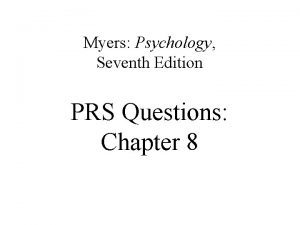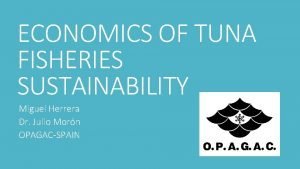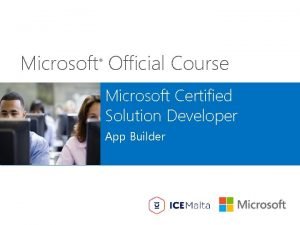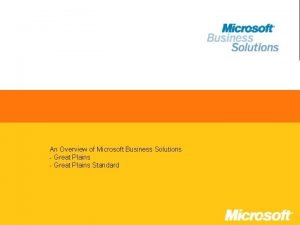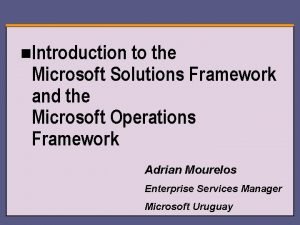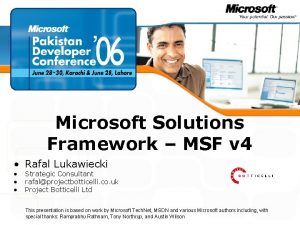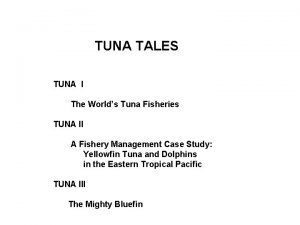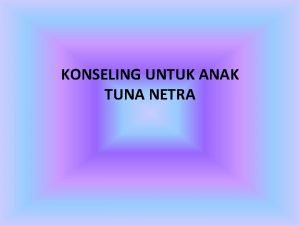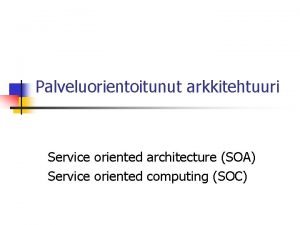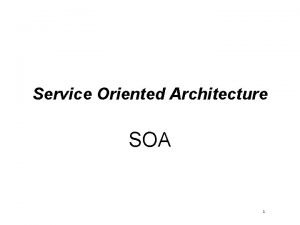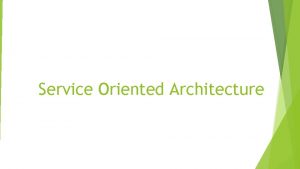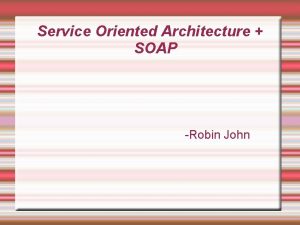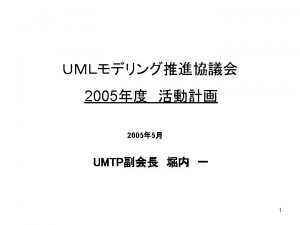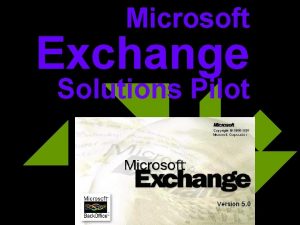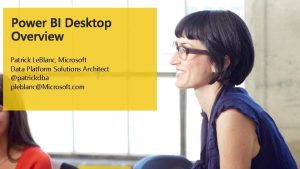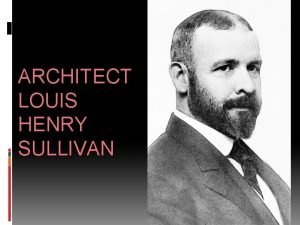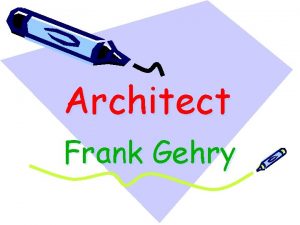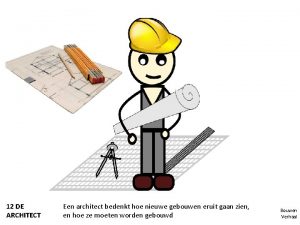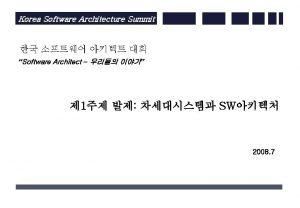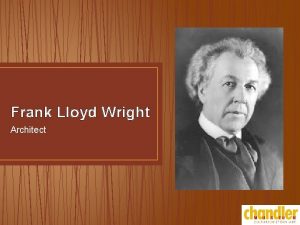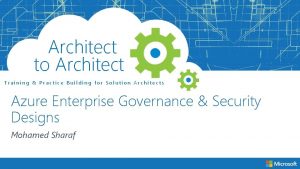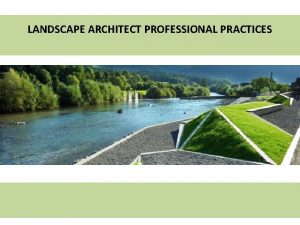Service Oriented Modelling Hatay Tuna Solutions Architect Microsoft














































- Slides: 46

Service Oriented Modelling Hatay Tuna Solutions Architect Microsoft

Head in the Cloud, Foot in the Mud THE FISH – HATAY TUNA

What to expect, what NOT to THE AGENDA

What to expect • What is Service Oriented Modelling – Also What is Microsoft Service Business Architecture • The Jargon – Concepts behind SOM • The Journey – Method and Practices • The Demo – Visual Studio and DSLs – Cool stuff? • The End – What’s next

First things first SERVICE ORIENTED MODELLING

What is SOM • Capability composed of methods and tools to enable incremental, repeatable, consistent and accountable service orientation within the enterprise or in the cloud based business architecture, service orientation software factory principals with focus on business value and alignment between business and IT architecture. . .

What is SOM • SOM is built on Microsoft Services Business Architecture (MSBA) • SOM is a Method supported by familiar Tools • SOM is optimised for – Service Orientation, – Business Process Automation – And Optimisation

Introduction to Business Architecture MICROSOFT SERVICE BUSINESS ARCHITECTURE

Why Business Architecture • Focus – Focus on “doing the right things” - what – Then “doing them right” - how • Context and Prioritisation – Provides structure to focus on “doing the right things” within the implementation – Logical, rational, and defensible • Optimisation – Services Orientation – Process Automation and Optimisation – Increased Productivity about “doing things right”

MSBA The Next Revolution in Productivity by Ric Merrifield, Jack Calhoun and Dennis Stevens Harvard School of Business, June 2008 http: //harvardbusinessonline. hbsp. harvard. edu/b 01/en/common/item_detail. jhtml? id=R 0806 D • Method to Decompose and Assess Capabilities • MSBA methodology delivers Business Architecture How and Where to Start with SOA Business Case and Justification Project Recommendations, Context and Prioritisation – Structure and Focus for SOA Decisions – – • Endorsed by the creators of – Six Sigma – Business process reengineering – Zachman • No need to spend 6– 12 months on SOA analysis and paralysis

Business Capability • Abstract view of what an individual business function does • Relationships to how (process) the business function is achieved and who (organization) • Properties are used to define the characteristics for both current and future state within the project context • Stable representation that will survive even if the implementation changes • Common naming convention is verb and noun sequence, for example: – • Provide Service, Request Resources, Manage Suppliers Durability: Centuries

Good times. . . Expecting Change? BP 1 - Business Process BC 1 - Business Capability BC 2 - Business Capability BC 3 - Business Capability BC 4 - Business Capability

Change happens. . . BP 1 - Business Process BC 1 - Business Capability BC 2 - Business Capability BC 3 - Business Capability BC 4 - Business Capability BC 3’ - Business Capability BC 4 - Business Capability

Change WILL happen. . . BP 1 - Business Process BC 1 - Business Capability BP 1’ - Business Process BC 1 - Business Capability BC 2 - Business Capability BC 3’ - Business Capability BC 3 - Business Capability BC 4 - Business Capability BC 2 - Business Capability

Most important slide of all. . . 1. Build a Foundation on Business Capabilities – Build on STABLE, NOT VOLATILE – Build your Architecture on WHAT, NOT HOW – Manage Change: Change One at a Time 2. Compose Business Capabilities with Business Processes 3. Expose Business Capabilities and Processes through Business Services 4. Consume Business Capabilities and Processes through Composite Applications Looks familiar? Yes, SOM is aligned with Read World SOA too!

Boring? NO, Exciting? YES! THE PHILOSOPHY

New stuff to think about. . . THE JARGON

The Jargon • Business Capability is an abstract view of what an individual business function does. . . • Business Capabilities are implemented by Service Components grouped by Business Services. . . • A Business Service is an contextual association between Business Capabilities and Service Components. . . • A Service Component may be software (Application, Web Service, Database. . . ), hardware (Mobile Phone, Printer, Devices. . . ) Business Capabilities Business Service Components

A to B: Vision to Value. . . THE JOURNEY

The Journey 1. Discover Business Capabilities 2. Assess Business Capabilities 3. Model Business Capabilities 4. Qualify Business Capabilities into Business Services 5. Define Business Services 6. Design and Model Service Components 7. Transform Service Components Business Capabilities are implemented by Business Services composed of Service Components Business Capabilities Business Service Components

Service Oriented Modelling 1. DISCOVER CAPABILITIES

Business Capability Map • Level 1 Foundational Capabilities – Operational Capabilities – Environmental Capabilities • Level 2 Capability Groups • Level 3+ Business Capabilities

Business Capability Map 2000+ Generic Capabilities and Industry Specific Templates Capital Markets Legal Retail Banking Retail Human Resources Insurance Professional Services Manage IT Services

Context and Focus This methodology provides a rapid process to decompose capabilities to granular levels.

MSBA Analytical Model

Service Oriented Modelling 2. ASSESS CAPABILITIES

Capability Assessment • Capture Properties – 180+ attributes to choose from – Inputs, Outputs, Exceptions, Service Level Expectations. . . • Then Assess – – – Business Value Contribution Performance Maturity Compliance and Regulations Interconnectedness

A lot to choose from. . . Purpose Owner Sourcing Affiliation Location Type Differentiating Process Reuse Source Version Customer Of Process(es) that use the Capability Dependency Capability(ies) Collaborative Capability(ies) Number of Dependencies Number of Dependent Capabilities Number of Collaborative Interactions Customer Satisfaction SLA/SLE Details Positive Variance Escalation Contact Positive Variance Notification Threshold Negative Variance Escalation Contact Negative Variance Notification Threshold Succession Plan Schedule Dependency Agreement/Contract Based Agreements/Contract Details Past Performance Desired Performance Best Practice Comparison Variability Volatility Human Interaction Value Add Process Variance Exceptions Electronic Input Output Data Used–Reference Data Used–Resource Data Used–Activity Triggering/Animating Function(s) Artifact(s)/Document(s) Created Security Functional Complexity Interface Complexity Passive/Active Request/Response on Inputs Offer/Acceptance at the Outset of the Capability Trigger Event Source Capability(ies) Content Filter Role Quantity Size Vertical Traditionally Outsourced Regulation-driven General

Service Oriented Modelling 3. MODEL CAPABILITIES

Capability Models • Interactions and Relationships between capabilities – Capabilities can trigger, support or control other Capabilities • Capability Models help you understand validate Business Processes. . .

Business Capability Model BC 1 - Business Capability BC 2 - Business Capability BC 3 - Business Capability BP 1 - Business Process BC 4 - Business Capability BC 3 - Business Capability BC 4 - Business Capability

Service Oriented Modelling 4. QUALIFY CAPABILITIES INTO SERVICES

Qualification • Qualification is the process of logically grouping implementation of one or more Business Capabilities into Business Services • Criteria are based on context and nature of the capabilities, there is NO single criteria that fit all but there are key questions and attributes: – Volatility, Outsourcing, Coupling, Shared Implementation Number for Time Performed, Success Metrics, Number of Consumers, Number of Dependencies. . .

Service Oriented Modelling 5. DEFINE SERVICES

Service Definition • Service Definition is the process of capturing characteristics and behaviour of the Business Service • Think requirements analysis, scenarios, requirements specifications, use-cases, service levels, non-functional requirements etc.

Service Oriented Modelling 6. MODEL SERVICES

Service Models • Service Modelling is the process of defining interactions between Service Components. . . • Interactions may represents scenarios, usecases. . . • Think Workflows, Sequence Diagrams. . .

Service Oriented Modelling 7. TRANSFORM SERVICES

Transformation • Transformation is the process of generating partially or fully complete technology models – Code, document, configuration, test. . . • WCF Contracts, Workflows, HTML Documentation, Class Libraries etc. • Transforming Models in SOM is 100% customisable and extensible to enable consistent and predictable results for specific needs – – XML/XSLT LINQ Text Templates SOM API

Practical Implementation of SOM in Visual Studio using DSLs THE DEMO

Summary THE END?

Remember? 1. Build a Foundation on Business Capabilities – Build on STABLE, NOT VOLATILE – Build your Architecture on WHAT, NOT HOW – Manage Change: Change One at a Time 2. Compose Business Capabilities with Business Processes 3. Expose Business Capabilities and Processes through Business Services 4. Consume Business Capabilities and Processes through Composite Applications Looks familiar? Yes, SOM is aligned with Read World SOA!

Value Pillars • Focus on Business Value and Alignment – Top-Down approach for Business Value – Bottom-up approach for Alignment with IT – Enterprise Architecture = (Enterprise) x (Business Architecture + IT Architecture) • Capability Model -> Service Model -> Technology Model • Optimised for S + S – Accountable Service Orientation in the Enterprise and in the Cloud – Practical, Incremental, Repeatable delivery for Consistent and Predictable Solutions • Rich and Extensible – Familiar Microsoft Office and Visual Studio – Industry, Business and Scenario specific Modelling – Flexible Transformation to Technology Models

The Technologies 1. Discover Business Capabilities 2. Assess Business Capabilities 3. Model Business Capabilities 4. Qualify Business Capabilities into Business Services 5. Define Business Services 6. Design and Model Service Components 7. Transform Service Components

Summary • SOA is the Journey, NOT the END – SOM fills a BIG GAP by • • SOM is already Released! – – SOM and MSBA are delivered through Microsoft Services SOM toolset is customisable and extensible for your needs • • “oslo” will be the platform of choice to perform SOM Get in Touch – – • Proven Methods and Familiar tools to tackle SOA Focus on Business Value Alignment between Business and IT Architecture Talk to your Microsoft representative, ask about SOM Contact me Watch Channel 9 Interview on SOM Start drawing some “Boxes and Lines” tomorrow! Don’t miss – “Oslo” - Microsoft's Vision for the Future of Modelling By Robert Hogg

Have a nice day and don’t forget to check-out other great sessions. . . THE GOODBYE
 Object oriented model adalah
Object oriented model adalah Soa
Soa Hatay mustafa kemal üniversitesi yatay geçiş
Hatay mustafa kemal üniversitesi yatay geçiş Trade-oriented sales promotion
Trade-oriented sales promotion Row oriented vs column oriented database
Row oriented vs column oriented database Web-oriented architecture
Web-oriented architecture Service oriented architecture notes
Service oriented architecture notes Characteristics of service oriented architecture
Characteristics of service oriented architecture Fiorano esb
Fiorano esb Service oriented architecture diagram
Service oriented architecture diagram Evolution of service oriented architecture
Evolution of service oriented architecture Service oriented infrastructure
Service oriented infrastructure Sca
Sca Service oriented architecture soap
Service oriented architecture soap Zooplankton
Zooplankton Tuna for lunch case study answers
Tuna for lunch case study answers Rehabstöd
Rehabstöd Tuna food web
Tuna food web Baki tuna yazıcı
Baki tuna yazıcı Baki tuna yazıcı
Baki tuna yazıcı Baki tuna yazıcı
Baki tuna yazıcı Baki tuna yazıcı
Baki tuna yazıcı Tuna yazıcı
Tuna yazıcı Ayrampo tuna
Ayrampo tuna Baki tuna yazıcı
Baki tuna yazıcı Tuna boat helicopter
Tuna boat helicopter Clean seas tuna
Clean seas tuna Oceanic food web
Oceanic food web Keuntungan bahan setengah jadi
Keuntungan bahan setengah jadi Akasya durağı stelyo gerçek adı
Akasya durağı stelyo gerçek adı Serhat turhan kimdir
Serhat turhan kimdir Pna tuna
Pna tuna Salvador domingo felipe jacinto
Salvador domingo felipe jacinto Tuna food web
Tuna food web Inferring phylogenies using derived characters
Inferring phylogenies using derived characters Gilles hosch
Gilles hosch Nama latin ikan tuna sirip biru
Nama latin ikan tuna sirip biru Brian ate a tuna salad sandwich
Brian ate a tuna salad sandwich Dr miguel tuna
Dr miguel tuna Msf process model
Msf process model App builder certification microsoft
App builder certification microsoft Microsoft business solutions great plains
Microsoft business solutions great plains Microsoft solutions framework
Microsoft solutions framework Msf process model
Msf process model Microsoft certified solutions master
Microsoft certified solutions master Microsoft official academic course microsoft word 2016
Microsoft official academic course microsoft word 2016 Microsoft official academic course microsoft excel 2016
Microsoft official academic course microsoft excel 2016


